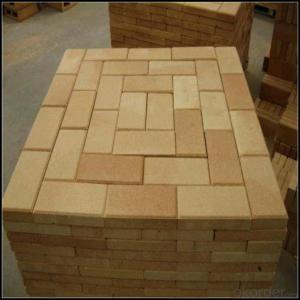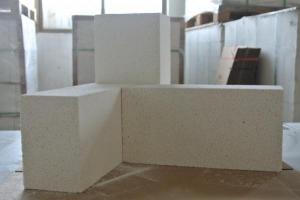Insulating Fire Brick for Steel/Cement/Glass Making Furnaces/Kilns
- Loading Port:
- Shanghai
- Payment Terms:
- TT OR LC
- Min Order Qty:
- 10 m.t.
- Supply Capability:
- 100 m.t./month
OKorder Service Pledge
OKorder Financial Service
You Might Also Like
Quick Details
| Place of Origin: | (Mainland) | Shape: | Brick | Material: | Alumina Block |
| SiO2 Content (%): | - | Al2O3 Content (%): | 42-75 | MgO Content (%): | - |
| CaO Content (%): | - | Refractoriness (Degree): | Common (1580°< Refractoriness< 1770°) | CrO Content (%): | 0 |
| SiC Content (%): | 0 | Model Number: | NG/LG/LZ | Brand Name: | |
| Sample: | Free | Name: | refractory brick | Bulk density: | 0.5-2.8 |
| Refractoriness: | 1150-1790 °C | RUI: | 1250-1520 °C | Apparent porosity: | ≤28 |
| CCS: | 1.5-54MPa | Fe2O3 Content (%): | ≤1.00/1.20/1.65/1.80 |
Packaging & Delivery
| Packaging Detail: | Fumigated wooden pallet, using paper or non-woven fabrics between layers separated, plastic shrink film protected outside, then the straps. Finally make the wooden pallet (95*95cm, 95*100cm) or as your requirements. |
| Delivery Detail: | 20 working days after deposit received. (based on real quantity) |
Specifications
All kinds of refractory brick for different industrial furnaces
28 year old manufacturer
ISO, TUV, SGS certificate
low prices
As a 28-year-old refractory material manufacturer, we have worked with many steel plants, metallurgic plants, cement plants, glass plants, provided them with top notch products and services. Here are the refractory bricks we produce:
| Brick Name | Application |
Clay brick | Normally used in the permanent layer of industrial kilns and furnaces, sometimes used in working layer. |
| Clay insulating brick | Normally used in the insulating layer of industrial kilns and furnaces. |
| High alumina brick | Mainly used in the working layer of blast furnace, airheater, EAF roof, reverberatory furnace, rotary kiln, etc.. It is also used as checker brick in regenerative chamber of open-hearth furnace, plug at gating system, shroud, etc.. |
| High alumina insulating brick | Normally used in the insulating layer of industrial kilns and furnaces. |
| High alumina EPS insulating brick | Normally used in the insulating layer of industrial kilns and furnaces. With higher strength than clay/high alumina insulating bricks. |
| Magnesia carbon brick | Used in working layer of ladle, refining ladle, converter, electric arc furnace, etc.. |
| Alumina-magnesite carbon brick | Used in working layer of ladle, pig iron ladle, electric arc furnace, etc.. |
| Magnesia-calcium brick | Used in working layer of electric arc furnace, refining furnace like AOD, VOD furnaces, etc.. |
| Magnesite-chrome brick | Used at high temperature zone and firing zone of rotary cement kiln. |
| Magnesia brick | Used in permanent layer of converter, AOD furnace, etc.. |
| AZS brick | Normally used at glass melting furnace hearth. |
| Silica brick | Partition wall of carbonization chamber and firing chamber of cock oven; Regenerative chamber and slag pocket of steelmaking open hearth furnace; Soaking pit furnace; Glass melting furnace; Weight bearing areas such as vault of the calcining kilns of refractory silica brick and ceramic; Weight bearing area of airheater; Roof of acid open hearth furnace. |
| Checker brick | Regenerative chamber of blast furnace hot blast stove, flame furnace. |
| Anchor brick | Normally used to strengthen refractory layers of industrial furnace or flue, or is used when the furnace body structure is too thick or overload or the temperature at working area is too high. |
| Baffle brick | Mainly used in regenerative chamber of heating furnace. |
| Purging plug | Blowing gas into the molten steel through it. |
| Purging plug seat block | Purging plug seat block |
| Low carbon brick | Normally used in the working layer of refining ladle, producing high class steel. |
| Carbon free brick | Normally used in the working layer of refining ladle, producing high class steel. |
| Alumina magnesia spinel brick | Mostly used at transitional area of rotary kiln. |
| Corundum brick | Widely used in many kinds of furnaces or kilns. |
| Al-SiC-C brick | Widely used in the working layer of blast furnace, foundry ladle, metal mixer, molten steel trough, etc.. |
If you are looking for solutions for steel making, cement making, alloy steel making, glass making, etc., please do not hesitate to contact us, we can help you with our products and experience
- Q: Can insulating fire bricks be used in the construction of heat shields?
- Yes, insulating fire bricks can be used in the construction of heat shields. Insulating fire bricks are specially designed to handle high temperatures and provide excellent thermal insulation. They can effectively absorb and distribute heat, making them ideal for creating heat shields that protect against intense heat and prevent it from reaching sensitive areas or materials.
- Q: Are insulating fire bricks resistant to water penetration?
- Insulating fire bricks exhibit resistance to water penetration. These bricks possess a low porosity and are fabricated from materials that do not readily absorb or retain water. Typically, they consist of lightweight refractory materials like alumina, silica, and other minerals that possess remarkable heat resistance and minimal water absorption capabilities. Consequently, insulating fire bricks are highly suitable for scenarios where water penetration could be detrimental, such as in high-temperature environments or when utilized as insulation in chimneys or kilns. However, it is essential to acknowledge that while these bricks resist water penetration, they are not entirely impervious to it. Prolonged exposure to water may eventually result in some degree of water absorption, which can impact their insulating properties. Therefore, it is prudent to exercise caution and ensure proper installation and maintenance to optimize their resistance against water penetration.
- Q: Are insulating fire bricks resistant to thermal stress?
- Yes, insulating fire bricks are designed to be highly resistant to thermal stress. They can withstand high temperatures without cracking or breaking, making them ideal for applications where thermal insulation and durability are required.
- Q: Do insulating fire bricks require any special insulation blankets or jackets?
- Yes, insulating fire bricks do require special insulation blankets or jackets in order to enhance their insulating properties and protect them from heat loss and damage. These blankets or jackets help to create a barrier that prevents the transfer of heat, ensuring maximum insulation and energy efficiency.
- Q: Are insulating fire bricks resistant to flame impingement?
- Yes, insulating fire bricks are resistant to flame impingement.
- Q: Can insulating fire bricks be used in steam boilers?
- Indeed, steam boilers can utilize insulating fire bricks. The purpose of insulating fire bricks is to possess minimal thermal conductivity, enabling them to efficiently retain and impede the transmission of heat from one side to the other. This renders them suitable for implementation in steam boilers, as they aid in enhancing energy efficiency by diminishing heat loss. Moreover, insulating fire bricks exhibit resistance to elevated temperatures, rendering them fitting for deployment in the steam boiler's high-temperature surroundings.
- Q: Can insulating fire bricks be used in the construction of flue liners?
- Flue liners can indeed incorporate insulating fire bricks. These bricks are specifically designed to endure high temperatures and offer exceptional insulation qualities. They are produced using lightweight materials like vermiculite or perlite, which possess minimal thermal conductivity. As a result, they are well-suited for lining flues as they effectively retain heat and enhance the flue system's efficiency. Moreover, insulating fire bricks exhibit resistance to thermal shock and can withstand sudden changes in temperature, a crucial factor in flue applications where temperatures may vary significantly. In conclusion, the use of insulating fire bricks in flue liner construction greatly enhances the flue system's performance and safety.
- Q: Can insulating fire bricks be used in the construction of lime production linings?
- Insulating fire bricks are capable of being utilized in the construction of lime production linings. These bricks are specifically designed to possess low thermal conductivity, making them exceptionally beneficial for applications that necessitate heat insulation. In the process of calcination that takes place during lime production, high temperatures are essential. By incorporating insulating fire bricks into the construction of lime production linings, heat loss can be minimized, thus enhancing energy efficiency. Furthermore, these bricks are lightweight and easy to manipulate, rendering them suitable for lining various components of lime kilns and other equipment employed in the lime production process. In summary, the utilization of insulating fire bricks in lime production linings has the potential to optimize the production process and enhance the overall performance of lime production facilities.
- Q: Do insulating fire bricks require any special cleaning procedures?
- Special cleaning procedures are not necessarily needed for insulating fire bricks. Nevertheless, just like any other substance, they can gather dust, dirt, or debris as time goes on, which may diminish their insulating capabilities. To uphold their effectiveness, it is suggested to occasionally eliminate any loose particles by gently brushing or vacuuming the surface of the bricks. If the bricks come into contact with oil or grease, it is recommended to utilize a mild detergent or soap solution for cleansing the affected regions. In general, consistent maintenance and preventing excessive accumulation will guarantee their optimal performance.
- Q: Can insulating fire bricks be used for insulation in steel mills?
- Yes, insulating fire bricks can be used for insulation in steel mills. Insulating fire bricks are made from lightweight refractory materials that have excellent insulating properties and can withstand high temperatures. They are designed to minimize heat transfer and maintain the desired temperature inside the furnace or kiln. In steel mills, these bricks can be used to insulate the walls, floors, and roofs of the furnaces, ladles, and other equipment. This insulation helps to reduce heat losses, improve energy efficiency, and ensure consistent and controlled heating processes. Additionally, insulating fire bricks can provide thermal stability and protect the steel mill equipment from excessive heat, contributing to longer equipment lifespan and reduced maintenance costs.
Send your message to us
Insulating Fire Brick for Steel/Cement/Glass Making Furnaces/Kilns
- Loading Port:
- Shanghai
- Payment Terms:
- TT OR LC
- Min Order Qty:
- 10 m.t.
- Supply Capability:
- 100 m.t./month
OKorder Service Pledge
OKorder Financial Service
Similar products
Hot products
Hot Searches
Related keywords


























